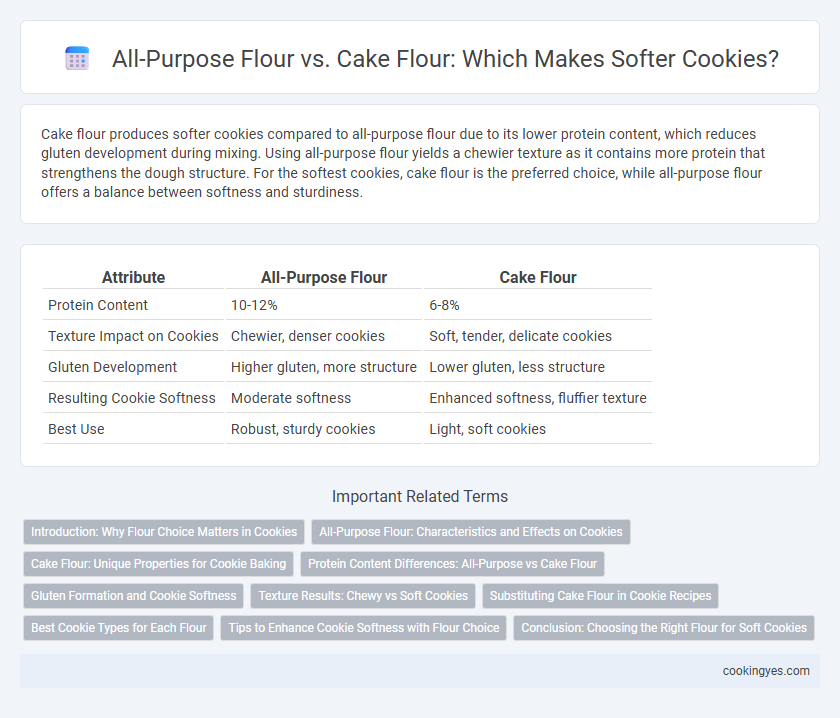Cake flour produces softer cookies compared to all-purpose flour due to its lower protein content, which reduces gluten development during mixing. Using all-purpose flour yields a chewier texture as it contains more protein that strengthens the dough structure. For the softest cookies, cake flour is the preferred choice, while all-purpose flour offers a balance between softness and sturdiness.
Table of Comparison
| Attribute | All-Purpose Flour | Cake Flour |
|---|---|---|
| Protein Content | 10-12% | 6-8% |
| Texture Impact on Cookies | Chewier, denser cookies | Soft, tender, delicate cookies |
| Gluten Development | Higher gluten, more structure | Lower gluten, less structure |
| Resulting Cookie Softness | Moderate softness | Enhanced softness, fluffier texture |
| Best Use | Robust, sturdy cookies | Light, soft cookies |
Introduction: Why Flour Choice Matters in Cookies
The choice between all-purpose flour and cake flour plays a crucial role in determining cookie softness due to their protein content differences, with cake flour having lower protein levels that result in a tender, delicate crumb. Cookies made with all-purpose flour tend to be chewier and denser because of its higher gluten-forming proteins. Understanding these flour properties enables bakers to achieve the desired soft texture in their cookie recipes.
All-Purpose Flour: Characteristics and Effects on Cookies
All-purpose flour contains a moderate protein content of around 10-12%, which provides enough gluten formation to create a balanced texture in cookies, offering softness with slight chewiness. Its versatility allows for cookies that spread moderately while maintaining structure, resulting in a tender bite without becoming cakey. Using all-purpose flour yields cookies with a golden exterior and chewy centers, making it ideal for traditional soft cookies like chocolate chip or oatmeal varieties.
Cake Flour: Unique Properties for Cookie Baking
Cake flour, with its lower protein content of around 7-8%, produces less gluten development compared to all-purpose flour's 10-12%, resulting in softer, more tender cookies. Its fine texture and high starch content absorb more liquid, creating a delicate crumb and enhancing cookie softness. Using cake flour in cookie recipes ensures a lighter, melt-in-the-mouth bite, ideal for achieving optimal softness and an airy texture.
Protein Content Differences: All-Purpose vs Cake Flour
All-purpose flour typically contains 10-12% protein, providing moderate gluten development that yields cookies with a balance of softness and structure. Cake flour has a lower protein content, around 7-9%, resulting in less gluten formation and producing softer, more tender cookies. Choosing cake flour over all-purpose flour enhances cookie softness due to its finer texture and reduced protein levels.
Gluten Formation and Cookie Softness
All-purpose flour contains higher protein content (10-12%) which forms more gluten strands, resulting in a chewier and denser cookie texture. Cake flour has lower protein content (7-9%), leading to minimal gluten formation and producing softer, tender cookies with a finer crumb. Choosing cake flour enhances cookie softness by reducing gluten development, while all-purpose flour creates a firmer bite due to stronger gluten networks.
Texture Results: Chewy vs Soft Cookies
All-purpose flour creates chewier cookies due to its higher protein content, which develops more gluten and provides a denser texture. Cake flour, with lower protein and finer milling, produces softer, more tender cookies that crumble easily. Choosing between these flours depends on whether a chewy bite or a soft, delicate texture is desired in the cookie.
Substituting Cake Flour in Cookie Recipes
Substituting cake flour in cookie recipes results in a softer, more tender texture due to its lower protein content compared to all-purpose flour. Cake flour's finer milling and reduced gluten formation create delicate, melt-in-your-mouth cookies ideal for achieving optimal softness. When using cake flour, reducing the liquid slightly can help maintain the dough consistency while enhancing cookie softness.
Best Cookie Types for Each Flour
All-purpose flour offers a balanced protein content around 10-12%, making it ideal for chewy, classic chocolate chip cookies that maintain structure while providing a tender bite. Cake flour, with its lower protein level of 7-9%, creates softer, more delicate cookies like sugar cookies and melt-in-your-mouth shortbread by producing less gluten and a finer crumb. Choosing cake flour enhances softness in light, crumbly cookies, whereas all-purpose flour supports richer, more robust cookie textures.
Tips to Enhance Cookie Softness with Flour Choice
Choosing cake flour over all-purpose flour enhances cookie softness due to its lower protein content, which reduces gluten formation and results in a tender texture. For optimal softness, consider substituting half of the all-purpose flour with cake flour, balancing structure and delicacy. Incorporating cornstarch with all-purpose flour also mimics cake flour's softness by further limiting gluten development.
Conclusion: Choosing the Right Flour for Soft Cookies
All-purpose flour contains a moderate protein content of 10-12%, providing structure and a slightly chewy texture to cookies, while cake flour has a lower protein content around 7-9%, resulting in softer and more tender cookies due to less gluten formation. For achieving soft cookies, cake flour is often preferred because its fine texture and lower gluten yield allow for a delicate crumb and melt-in-the-mouth quality. Selecting cake flour over all-purpose flour consistently enhances cookie softness, making it the optimal choice for recipes prioritizing tenderness.
All-purpose flour vs Cake flour for cookie softness Infographic

 cookingyes.com
cookingyes.com